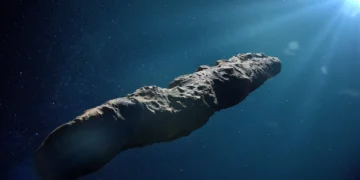Astronomy has always been a field of surprises, and the recent discovery of seven additional dark comets in our solar system adds a new layer of intrigue to the cosmos. These celestial objects defy the traditional definitions of asteroids and comets, presenting unique challenges to astronomers. With this discovery, the tally of known dark comets has doubled, sparking excitement among scientists eager to unravel their mysteries.
What Are Dark Comets?
Dark comets are celestial objects that blur the line between asteroids and comets. Unlike traditional comets, they lack visible tails formed by outgassing of volatile materials. Yet, their behavior—accelerating in ways similar to comets—suggests there is more to them than meets the eye.
For instance, these objects defy expectations typically associated with asteroids. While an asteroid’s motion can often be explained by sunlight heating its surface, dark comets exhibit unexpected shifts in their orbits.
The fascination with dark comets began in earnest in 2017, with the discovery of 1I/2017 U1 (‘Oumuamua), an interstellar object that moved in a way consistent with cometary outgassing but lacked any visible tail.
How Were These Seven New Dark Comets Discovered?
The recent discovery was made using advanced observation techniques that relied on precise monitoring of celestial movements. Astronomers employed state-of-the-art telescopes to track these objects, noting their unusual orbits and behavior.
NASA’s Jet Propulsion Laboratory played a key role in identifying these new members of the dark comet family. By carefully analyzing their trajectories, scientists noticed perturbations consistent with forces acting on volatile materials hidden beneath their surfaces.
One group orbits the outer solar system, displaying long and eccentric paths reminiscent of Jupiter-family comets. The other group is found closer to the Sun, with near-circular orbits between Mercury and Mars.
What Makes Dark Comets Unique?
Dark comets are fascinating because they challenge our understanding of celestial classification. Their orbits, sizes, and lack of visible outgassing set them apart from typical comets. For example, the new findings suggest that dark comets in the outer solar system resemble traditional ice-rich bodies, while those closer to the Sun are smaller and less reflective.
The absence of visible tails complicates their study. Traditional comets are easily identified by the bright halos created when their ices vaporize under solar heating. Dark comets, however, remain shrouded in mystery, as telescopes have yet to detect clear signs of such outgassing.
Why Are Dark Comets Important?
Dark comets hold significant scientific value, as they could provide clues about the origins of our solar system and the building blocks of life. Some researchers believe that these objects might have played a role in delivering water and organic compounds to Earth billions of years ago.
According to Darryl Seligman, a physicist at Michigan State University, “Dark comets are a new potential source for having delivered the materials to Earth that were necessary for the development of life.” This idea suggests that dark comets could have ferried essential elements across the solar system, contributing to the emergence of life on our planet.
Theories About Their Origins
Where do dark comets come from? One theory suggests that they formed from the same raw materials as regular comets—ice and dust—but underwent transformations that concealed their comet-like traits. For example, collisions or exposure to extreme conditions might have stripped away their bright halos, leaving behind dark, inert surfaces.
Another possibility is that these objects are remnants of a bygone era in the solar system’s history. Their unusual orbits and compositions hint at a complex origin story that scientists are eager to unravel.
Future Research and Exploration
The discovery of seven new dark comets is just the beginning. Astronomers are now planning follow-up observations and missions to study these objects in greater detail. Advanced imaging technologies and ground-based observatories will play a crucial role in this endeavor.
Some researchers have proposed sending spacecraft to rendezvous with dark comets. Such missions could collect samples and directly analyze their composition, providing invaluable data about their hidden ices and volatile materials.
The potential for future discoveries is immense. As observation techniques improve, astronomers hope to identify even more dark comets and expand our understanding of their role in the solar system. Two distinct populations of dark comets delineated by orbits and sizes
Conclusion
The discovery of seven new dark comets is a milestone in the field of astronomy. These enigmatic objects challenge our understanding of the solar system and open new avenues for exploration and discovery. By studying their unique properties, scientists hope to uncover the secrets of their origins, composition, and role in the solar system’s history.
Reference:
Two distinct populations of dark comets delineated by orbits and sizes



















